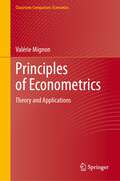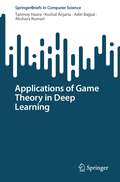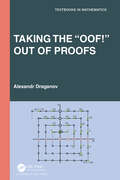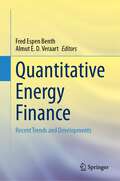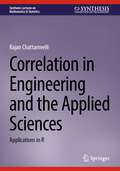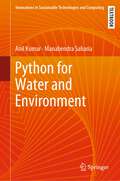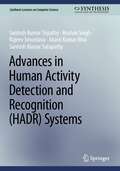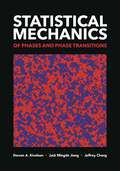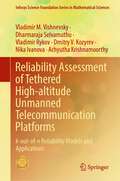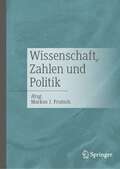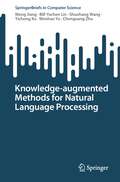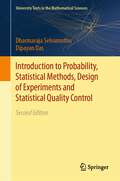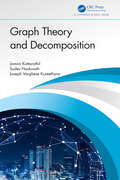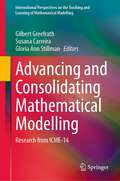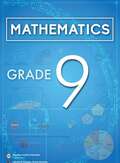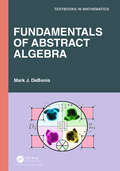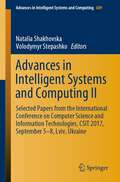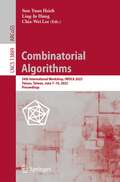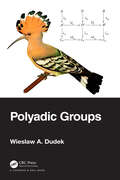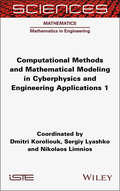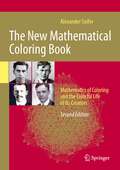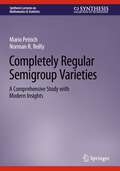- Table View
- List View
Principles of Econometrics: Theory and Applications (Classroom Companion: Economics)
by Valérie MignonThis textbook teaches the basics of econometrics and focuses on the acquisition of methods and skills that are essential for any student to succeed in their studies, as well as for any practitioner interested in applying econometric techniques. Employing a pedagogical and easy-to-follow style, the book puts into practice the various concepts presented, such as statistics, tests, and methods, among others. Numerous examples and empirical applications using existing econometric and statistical software are given after each theoretical presentation.The book addresses students at the undergraduate and graduate levels in economics and management, as well as students of engineering and business schools. It will further appeal to professionals and practitioners of econometrics, such as economists and researchers in companies and institutions, who will find practical solutions to the different problems they are confronted with.
Applications of Game Theory in Deep Learning (SpringerBriefs in Computer Science)
by Tanmoy Hazra Kushal Anjaria Aditi Bajpai Akshara KumariThis book aims to unravel the complex tapestry that interweaves strategic decision-making models with the forefront of deep learning techniques. Applications of Game Theory in Deep Learning provides an extensive and insightful exploration of game theory in deep learning, diving deep into both the theoretical foundations and the real-world applications that showcase this intriguing intersection of fields. Starting with the essential foundations for comprehending both game theory and deep learning, delving into the individual significance of each field, the book culminates in a nuanced examination of Game Theory's pivotal role in augmenting and shaping the development of Deep Learning algorithms. By elucidating the theoretical underpinnings and practical applications of this synergistic relationship, we equip the reader with a comprehensive understanding of their combined potential. In our digital age, where algorithms and autonomous agents are becoming more common, the combination of game theory and deep learning has opened a new frontier of exploration. The combination of these two disciplines opens new and exciting avenues. We observe how artificial agents can think strategically, adapt to ever-shifting environments, and make decisions that are consistent with their goals and the dynamics of their surroundings. This book presents case studies, methodologies, and real-world applications.
Taking the “Oof!” Out of Proofs (Textbooks in Mathematics)
by Alexandr DraganovThis book introduces readers to the art of doing mathematical proofs. Proofs are the glue that holds mathematics together. They make connections between math concepts and show why things work the way they do. This book teaches the art of proofs using familiar high-school concepts, such as numbers, polynomials, functions, and trigonometry. It retells math as a story, where the next chapter follows from the previous one.Readers will see how various mathematical concepts are tied and will see that mathematics is not a pile of formulas and facts; rather, it has an orderly and beautiful edifice.The author begins with basic rules of logic and then progresses through the topics already familiar to the students: numbers, inequalities, functions, polynomials, exponents, and trigonometric functions. There are also beautiful proofs for conic sections, sequences, and Fibonacci numbers. Each chapter has exercises for the reader.Reviewer Comments:I find the book very impressive. The choice and sequence of topics is excellent, and it is wonderful to have all of these things together in one volume. Theorems are clearly stated, and proofs are accurate. – Michael ComenetzThe thoroughness of the narrative is one of the main strengths of the book. The book provides a perfect illustration of mathematical thinking. Each step of a given derivation is precise and clear. – Julie GershunskayaDraganov’s book stands out from the many competing books. Draganov’s goal is to show that mathematics depends on the notion of proof. Unlike other transition books, he addresses mathematical topics at an accessible level, rather than topics studied later in the university curriculum. – Ken Rosen
Taking the “Oof!” Out of Proofs: A Primer On Mathematical Proofs (Textbooks in Mathematics)
by Alexandr DraganovThis book introduces readers to the art of doing mathematical proofs. Proofs are the glue that holds mathematics together. They make connections between math concepts and show why things work the way they do. This book teaches the art of proofs using familiar high-school concepts, such as numbers, polynomials, functions, and trigonometry. It retells math as a story, where the next chapter follows from the previous one.Readers will see how various mathematical concepts are tied and will see that mathematics is not a pile of formulas and facts; rather, it has an orderly and beautiful edifice.The author begins with basic rules of logic and then progresses through the topics already familiar to the students: numbers, inequalities, functions, polynomials, exponents, and trigonometric functions. There are also beautiful proofs for conic sections, sequences, and Fibonacci numbers. Each chapter has exercises for the reader.Reviewer Comments:I find the book very impressive. The choice and sequence of topics is excellent, and it is wonderful to have all of these things together in one volume. Theorems are clearly stated, and proofs are accurate. – Michael ComenetzThe thoroughness of the narrative is one of the main strengths of the book. The book provides a perfect illustration of mathematical thinking. Each step of a given derivation is precise and clear. – Julie GershunskayaDraganov’s book stands out from the many competing books. Draganov’s goal is to show that mathematics depends on the notion of proof. Unlike other transition books, he addresses mathematical topics at an accessible level, rather than topics studied later in the university curriculum. – Ken Rosen
Quantitative Energy Finance: Recent Trends and Developments
by Fred Espen Benth Almut E. D. VeraartPower markets are undergoing a major transformation from gas and oil-fueled generation toward renewable electricity production from wind and solar sources. Simultaneously, there is an increasing demand for electrification, coupled with long-term climate-induced weather changes. The uncertainties confronting energy market participants require sophisticated modelling techniques to effectively understand risk, many of which are covered in this book.Comprising invited papers by high-profile researchers, this volume examines the empirical aspects of forward and futures prices, uncovering patterns of noise factors in various European electricity markets. Additionally, it delves into the recent, influential classes of Hawkes and trawl processes, emphasizing their significance in energy markets. The impact of renewables on energy market prices is a pivotal concern for both producers and consumers. Mean-field games provide a powerful mathematical framework for this, and a dedicated chapter outlining their dynamics is included in the book. The book also explores structural financial products and their connection to climate risk as a risk management tool, underscoring the essential need for a comprehensive understanding of these products in the realm of "green finance," to which the energy industry is integral. Lastly, the book thoroughly analyzes spatial smoothing and power purchase (PPA) contracts, addressing central issues in energy system planning and financial operations.Tailored for researchers, PhD students, and industry energy analysts, this volume equips readers with insights and tools to navigate the constantly evolving energy market landscape. It serves as a sequel to the earlier Quantitative Energy Finance book, featuring all-new chapters.
Correlation in Engineering and the Applied Sciences: Applications in R (Synthesis Lectures on Mathematics & Statistics)
by Rajan ChattamvelliThis book focuses on correlation coefficients and its applications in applied science fields. The book begins by describing the historical development and various types of correlations. Rank correlation methods including Pearson’s, Spearman’s, and Kendall’s correlation are discussed at length. The book also discusses sampling distribution of correlation coefficients and applications of correlations in various fields. The book presents novel topics such as (i) a quick analytical method to approximate Pearson's correlation, (ii) single-variable correlation, (iii) fractional co-skewness and co-kurtosis, and (iv) the fallacy on correlation between the sample mean and sample variance. This book is ideal for courses on mathematical statistics, engineering statistics, and exploratory data analysis and is primarily aimed at upper-undergraduate and graduate level students. The book is also useful for researchers and professionals in various fields who are interested in data analysis.
Python for Water and Environment (Innovations in Sustainable Technologies and Computing)
by Anil Kumar Manabendra SahariaThis textbook delves into the practical applications of surface and groundwater hydrology, as well as the environment. The Part I, "Practical Python for a Water and Environment Professional," guides readers through setting up a scientific computing environment and conducting exploratory data analysis and visualization using reproducible workflows. The Part II, "Statistical Modeling in Hydrology," covers regression models, time series analysis, and common hypothesis testing. The Part III, "Surface and Subsurface Water," illustrates the use of Python in understanding key concepts related to seepage, groundwater, and surface water flows. Lastly, the Part IV, "Environmental Applications," demonstrates the application of Python in the study of various contaminant transport phenomena.
Advances in Human Activity Detection and Recognition (Synthesis Lectures on Computer Science)
by Santosh Kumar Tripathy Roshan Singh Rajeev Srivastava Akash Kumar Bhoi Santosh Kumar SatapathyThis book provides a comprehensive overview of Human Activity Detection or Recognition (HADR) systems. Detection or recognition of human activities is a prominent research area in the fields of computer vision and artificial intelligence because of its many applications in daily life, including monitoring in public transport areas, health monitoring, anomaly detection in traffic, and smart homes. This book divides different activities according to their criticality, then discusses the various motivations and challenges that are involved in HADR systems. The authors then propose a framework for activity detection or recognition. The book also covers ten key applications of HADR systems and the recent developments for each of them. The authors also propose areas for future research.
Statistical Mechanics of Phases and Phase Transitions
by Steven A. Kivelson Jack Mingde Jiang Jeffrey ChangAn engaging undergraduate introduction to the statistical mechanics of phase transitionsStatistical mechanics deploys a powerful set of mathematical approaches for studying the thermodynamic properties of complex physical systems. This textbook introduces students to the statistical mechanics of systems undergoing changes of state, focusing on the basic principles for classifying distinct thermodynamic phases and the critical phenomena associated with transitions between them. Uniquely designed to promote active learning, Statistical Mechanics of Phases and Phase Transitions presents some of the most beautiful and profound concepts in physics, enabling students to obtain an essential understanding of a computationally challenging subject without getting lost in the details.Provides a self-contained, conceptually deep introduction to the statistical mechanics of phases and phase transitions from a modern perspectiveCarefully leads students from spontaneously broken symmetries to the universality of phase transitions and the renormalization groupEncourages student-centric active learning suitable for both the classroom and self-studyFeatures a wealth of guided worksheets with full solutions throughout the book that help students learn by doingIncludes informative appendixes that cover key mathematical concepts and methodsIdeal for undergraduate physics majors and beginning graduate studentsSolutions manual for all end-of-chapter problems (available only to instructors)
Reliability Assessment of Tethered High-altitude Unmanned Telecommunication Platforms: k-out-of-n Reliability Models and Applications (Infosys Science Foundation Series)
by Vladimir M. Vishnevsky Dharmaraja Selvamuthu Vladimir Rykov Dmitry V. Kozyrev Nika Ivanova Achyutha KrishnamoorthyThis book provides a systematic presentation of the major results in the field of the theory of k-out-of-n systems obtained in recent years and their applications for the reliability assessment of high-altitude unmanned platforms. Mathematical models, methods, and algorithms, presented in the book, will make a significant contribution to the development of reliability theory and the theoretical foundations of unmanned UAV-based aerial communications networks in the framework of the concept of creating the 5G and beyond networks. The book gives a description of new mathematical methods and approaches (based on decomposable semi-regenerative processes, simulation and machine learning methods, and inventory models) to the study of the complex k-out-of-n systems, which makes it possible to carry out numerical calculations of reliability indicators. Organized into five chapters, each chapter begins with a summary of the main definitions andresults contained in the chapter. The content of this book is based on the original results developed by the authors, many of which appear for the first time in book form.
Wissenschaft, Zahlen und Politik
by Markus J. PrutschDiese Studie untersucht die dynamische Beziehung zwischen Wissenschaft, Zahlen und Politik. Was können wissenschaftliche Erkenntnisse realistischerweise in und für die Politik tun? Der Band leistet einen Beitrag zu dieser Debatte, indem er sich auf die Rolle von "Zahlen" als Mittel konzentriert, mit dem Wissen ausgedrückt wird und durch das dieses Wissen in den politischen Bereich übertragen werden kann. Ausgehend von der Annahme, dass Zahlen ständig aktiv geschaffen, übersetzt und verwendet werden und dass sie in ihren jeweiligen Kontexten interpretiert werden müssen, wird untersucht, wie Zahlen und Quantifizierungen "politisch nutzbar" gemacht werden, indem ihre Produktion, ihr Übergang in die Sphäre der Politik und ihre letztendliche Verwendung darin untersucht werden. Zu den zentralen Fragen, die behandelt werden, gehören: Auf welche Weise beeinflussen wissenschaftliche Erkenntnisse die politische Entscheidungsfindung in der heutigen Welt? Wie und warum hat Quantifizierung in der demokratischen Politik eine so wichtige Rolle gespielt? Was leisten wissenschaftliche Erkenntnisse und Zahlen in der Politik?
Knowledge-augmented Methods for Natural Language Processing (SpringerBriefs in Computer Science)
by Meng Jiang Bill Yuchen Lin Shuohang Wang Yichong Xu Wenhao Yu Chenguang ZhuOver the last few years, natural language processing has seen remarkable progress due to the emergence of larger-scale models, better training techniques, and greater availability of data. Examples of these advancements include GPT-4, ChatGPT, and other pre-trained language models. These models are capable of characterizing linguistic patterns and generating context-aware representations, resulting in high-quality output. However, these models rely solely on input-output pairs during training and, therefore, struggle to incorporate external world knowledge, such as named entities, their relations, common sense, and domain-specific content. Incorporating knowledge into the training and inference of language models is critical to their ability to represent language accurately. Additionally, knowledge is essential in achieving higher levels of intelligence that cannot be attained through statistical learning of input text patterns alone. In this book, we will review recent developmentsin the field of natural language processing, specifically focusing on the role of knowledge in language representation. We will examine how pre-trained language models like GPT-4 and ChatGPT are limited in their ability to capture external world knowledge and explore various approaches to incorporate knowledge into language models. Additionally, we will discuss the significance of knowledge in enabling higher levels of intelligence that go beyond statistical learning on input text patterns. Overall, this survey aims to provide insights into the importance of knowledge in natural language processing and highlight recent advances in this field.
Introduction to Probability, Statistical Methods, Design of Experiments and Statistical Quality Control (University Texts in the Mathematical Sciences)
by Dharmaraja Selvamuthu Dipayan DasThis revised book provides an accessible presentation of concepts from probability theory, statistical methods, the design of experiments, and statistical quality control. It is shaped by the experience of the two teachers teaching statistical methods and concepts to engineering students. Practical examples and end-of-chapter exercises are the highlights of the text, as they are purposely selected from different fields. Statistical principles discussed in the book have a great relevance in several disciplines like economics, commerce, engineering, medicine, health care, agriculture, biochemistry, and textiles to mention a few.Organised into 16 chapters, the revised book discusses four major topics—probability theory, statistical methods, the design of experiments, and statistical quality control. A large number of students with varied disciplinary backgrounds need a course in basics of statistics, the design of experiments and statistical quality control at an introductory level to pursue their discipline of interest. No previous knowledge of probability or statistics is assumed, but an understanding of calculus is a prerequisite. The whole book also serves as a master level introductory course in all the three topics, as required in textile engineering or industrial engineering.
Graph Theory and Decomposition
by Jomon Kottarathil Sudev Naduvath Joseph Varghese KureetharaThe book Graph Theory and Decomposition covers major areas of the decomposition of graphs. It is a three-part reference book with nine chapters that is aimed at enthusiasts as well as research scholars. It comprehends historical evolution and basic terminologies, and it deliberates on decompositions into cyclic graphs, such as cycle, digraph, and K4-e decompositions. In addition to determining the pendant number of graphs, it has a discourse on decomposing a graph into acyclic graphs like general tree, path, and star decompositions. It summarises another recently developed decomposition technique, which decomposes the given graph into multiple types of subgraphs. Major conjectures on graph decompositions are elaborately discussed. It alludes to a comprehensive bibliography that includes over 500 monographs and journal articles. It includes more than 500 theorems, around 100 definitions, 56 conjectures, 40 open problems, and an algorithm. The index section facilitates easy access to definitions, major conjectures, and named theorems.Thus, the book Graph Theory and Decomposition will be a great asset, we hope, in the field of decompositions of graphs and will serve as a reference book for all who are passionate about graph theory.
Graph Theory and Decomposition
by Jomon Kottarathil Sudev Naduvath Joseph Varghese KureetharaThe book Graph Theory and Decomposition covers major areas of the decomposition of graphs. It is a three-part reference book with nine chapters that is aimed at enthusiasts as well as research scholars. It comprehends historical evolution and basic terminologies, and it deliberates on decompositions into cyclic graphs, such as cycle, digraph, and K4-e decompositions. In addition to determining the pendant number of graphs, it has a discourse on decomposing a graph into acyclic graphs like general tree, path, and star decompositions. It summarises another recently developed decomposition technique, which decomposes the given graph into multiple types of subgraphs. Major conjectures on graph decompositions are elaborately discussed. It alludes to a comprehensive bibliography that includes over 500 monographs and journal articles. It includes more than 500 theorems, around 100 definitions, 56 conjectures, 40 open problems, and an algorithm. The index section facilitates easy access to definitions, major conjectures, and named theorems.Thus, the book Graph Theory and Decomposition will be a great asset, we hope, in the field of decompositions of graphs and will serve as a reference book for all who are passionate about graph theory.
Advancing and Consolidating Mathematical Modelling: Research from ICME-14 (International Perspectives on the Teaching and Learning of Mathematical Modelling)
by Gilbert Greefrath Susana Carreira Gloria Ann StillmanThis edited volume presents applications and modelling as a world-renowned sub-field of research in mathematics education. It includes the discussion on students’ development of modelling competency through the teaching of applications and modelling. The teaching of mathematical modelling is considered from different perspectives, such as mathematical, pedagogical-didactical perspectives and critical-societal or socio-political perspectives. Assessment practices (local, regional or international) of modelling activities and difficulties with modelling activities at school and university levels, respectively, are discussed. Use of technology and other resources in modelling activities and their impact on the modelling processes are included in the considerations. Teaching practices, teacher education and professional development programs concerning the integration of applications and modelling in school and university mathematics programs are developedin this context.
Mathematics class 9 - MIE
by Mauritius Institute of EducationPublished by the Mauritius Institute of Education in 2021, the Grade 9 mathematics textbook offers a comprehensive alignment with the National Curriculum Framework, prioritizing the enhancement of learners' cognitive abilities through contextualized materials. Covering a range of topics including indices, binomial expressions, quadratics, and algebraic manipulation, the textbook incorporates exercises and continuous assessments to reinforce learning. Rooted in Variation Theory, the pedagogical approach aims to facilitate students' discernment of key concepts within each topic, fostering procedural fluency. This collaborative effort between MIE academics and seasoned educators ensures the delivery of high-quality content that effectively meets educational objectives, providing students with a solid foundation in mathematics.
Fundamentals of Abstract Algebra (Textbooks in Mathematics)
by Mark J. DeBonisFundamentals of Abstract Algebra is a primary textbook for a one year first course in Abstract Algebra, but it has much more to offer besides this. The book is full of opportunities for further, deeper reading, including explorations of interesting applications and more advanced topics, such as Galois theory. Replete with exercises and examples, the book is geared towards careful pedagogy and accessibility, and requires only minimal prerequisites. The book includes a primer on some basic mathematical concepts that will be useful for readers to understand, and in this sense the book is self-contained.Features Self-contained treatments of all topics Everything required for a one-year first course in Abstract Algebra, and could also be used as supplementary reading for a second course Copious exercises and examples Mark DeBonis received his PhD in Mathematics from the University of California, Irvine, USA. He began his career as a theoretical mathematician in the field of group theory and model theory, but in later years switched to applied mathematics, in particular to machine learning. He spent some time working for the US Department of Energy at Los Alamos National Lab as well as the US Department of Defense at the Defense Intelligence Agency, both as an applied mathematician of machine learning. He held a position as Associate Professor of Mathematics at Manhattan College in New York City, but later left to pursue research working for the US Department of Energy at Sandia National Laboratory as a Principal Data Analyst. His research interests include machine learning, statistics and computational algebra.
Fundamentals of Abstract Algebra (Textbooks in Mathematics)
by Mark J. DeBonisFundamentals of Abstract Algebra is a primary textbook for a one year first course in Abstract Algebra, but it has much more to offer besides this. The book is full of opportunities for further, deeper reading, including explorations of interesting applications and more advanced topics, such as Galois theory. Replete with exercises and examples, the book is geared towards careful pedagogy and accessibility, and requires only minimal prerequisites. The book includes a primer on some basic mathematical concepts that will be useful for readers to understand, and in this sense the book is self-contained.Features Self-contained treatments of all topics Everything required for a one-year first course in Abstract Algebra, and could also be used as supplementary reading for a second course Copious exercises and examples Mark DeBonis received his PhD in Mathematics from the University of California, Irvine, USA. He began his career as a theoretical mathematician in the field of group theory and model theory, but in later years switched to applied mathematics, in particular to machine learning. He spent some time working for the US Department of Energy at Los Alamos National Lab as well as the US Department of Defense at the Defense Intelligence Agency, both as an applied mathematician of machine learning. He held a position as Associate Professor of Mathematics at Manhattan College in New York City, but later left to pursue research working for the US Department of Energy at Sandia National Laboratory as a Principal Data Analyst. His research interests include machine learning, statistics and computational algebra.
Advances in Intelligent Systems and Computing II: Selected Papers from the International Conference on Computer Science and Information Technologies, CSIT 2017, September 5-8 Lviv, Ukraine (Advances in Intelligent Systems and Computing #689)
by Natalia Shakhovska Volodymyr StepashkoThis book reports on new theories and applications in the field of intelligent systems and computing. It covers computational and artificial intelligence methods, as well as advances in computer vision, current issues in big data and cloud computing, computation linguistics, and cyber-physical systems. It also reports on data mining and knowledge extraction technologies, as well as central issues in intelligent information management. Written by active researchers, the respective chapters are based on papers presented at the International Conference on Computer Science and Information Technologies (CSIT 2017), held on September 5–8, 2017, in Lviv, Ukraine; and at two workshops accompanying the conference: one on inductive modeling, jointly organized by the Lviv Polytechnic National University and the National Academy of Science of Ukraine; and another on project management, which was jointly organized by the Lviv Polytechnic National University, the International Project Management Association, the Ukrainian Project Management Association, the Kazakhstan Project Management Association, and Nazarbayev University. Given its breadth of coverage, the book provides academics and professionals with extensive information and a timely snapshot of the field of intelligent systems, and is sure to foster new discussions and collaborations among different groups.
Combinatorial Algorithms: 34th International Workshop, IWOCA 2023, Tainan, Taiwan, June 7–10, 2023, Proceedings (Lecture Notes in Computer Science #13889)
by Sun-Yuan Hsieh Ling-Ju Hung Chia-Wei LeeThis book constitutes the refereed proceedings of the 34th International Workshop on Combinatorial Algorithms, IWOCA 2023, held in Tainan, Taiwan, during June 7–10, 2023. The 33 full papers included in this book were carefully reviewed and selected from 86 submissions. They were organized in topical sections as follows: algorithms and data structures; algorithmic and combinatorical aspects of cryptography and information security; algorithmic game theory and complexity of games; approximation algorithms; complexity theory; combinatorics and graph theory; combinatorial generation, enumeration and counting; combinatorial optimization; combinatorics of words; computational biology; computational geometry; decompositions and combinatorial designs; distributed and network algorithms; experimental combinatorics; fine-grained complexity; graph algorithms and modelling with graphs; graph drawing and graph labelling; network theoryand temporal graphs; quantum computing and algorithms for quantum computers; online algorithms; parameterized and exact algorithms; probabilistic and randomized algorithms; and streaming algorithms.
Polyadic Groups
by Wieslaw A. DudekThis book provides a general, unified approach to the theory of polyadic groups, their normal subgroups and matrix representations.The author focuses on those properties of polyadic groups which are not present in the binary case. These properties indicate a strong relationship between polyadic groups and various group-like algebras, as well as ternary Hopf algebras and n-Lie algebras that are widely used in theoretical physics.The relationships of polyadic groups with special types of binary groups, called covering groups and binary retracts, are described. These relationships allow the study of polyadic groups using these binary groups and their automorphisms.The book also describes the affine geometry induced by polyadic groups and fuzzy subsets defined on polyadic groups. Finally, we discuss the categories of polyadic groups and the relationships between the different varieties of polyadic groups. In many cases, we give elegant new proofs of known theorems. We also give many interesting examples and applications.The book contains many little-known results from articles previously published in hard-to-reach Russian, Ukrainian and Macedonian journals. These articles are not in English.
Computational Methods and Mathematical Modeling in Cyberphysics and Engineering Applications 1
by Dmitri Koroliouk Sergiy Lyashko Nikolaos LimniosMathematical methods in engineering are characterized by a wide range of techniques for approaching various problems. Moreover, completely different analysis techniques can be applied to the same problem, which is justified by the difference in specific applications. Therefore, the study of the analyses and solutions of specific problems leads the researcher to generate their own techniques for the analysis of similar problems continuously arising in the process of technical development. Computational Methods and Mathematical Modeling in Cyberphysics and Engineering Applications contains solutions to specific problems in current areas of computational engineering and cyberphysics.
The New Mathematical Coloring Book: Mathematics of Coloring and the Colorful Life of Its Creators
by Alexander SoiferThe New Mathematical Coloring Book (TNMCB) includes striking results of the past 15-year renaissance that produced new approaches, advances, and solutions to problems from the first edition. A large part of the new edition “Ask what your computer can do for you,” presents the recent breakthrough by Aubrey de Grey and works by Marijn Heule, Jaan Parts, Geoffrey Exoo, and Dan Ismailescu. TNMCB introduces new open problems and conjectures that will pave the way to the future keeping the book in the center of the field. TNMCB presents mathematics of coloring as an evolution of ideas, with biographies of their creators and historical setting of the world around them, and the world around us.A new thing in the world at the time, TMCB I is now joined by a colossal sibling containing more than twice as much of what only Alexander Soifer can deliver: an interweaving of mathematics with history and biography, well-seasoned with controversy and opinion. –Peter D. Johnson, Jr.Auburn UniversityLike TMCB I, TMCB II is a unique combination of Mathematics, History, and Biography written by a skilled journalist who has been intimately involved with the story for the last half-century. …The nature of the subject makes much of the material accessible to students, but also of interest to working Mathematicians. … In addition to learning some wonderful Mathematics, students will learn to appreciate the influences of Paul Erdős, Ron Graham, and others.–Geoffrey ExooIndiana State UniversityThe beautiful and unique Mathematical coloring book of Alexander Soifer is another case of “good mathematics”, containing a lot of similar examples (it is not by chance that Szemerédi’s Theorem story is included as well) and presenting mathematics as both a science and an art…–Peter MihókMathematical Reviews, MathSciNetA postman came to the door with a copy of the masterpiece of the century. I thank you and the mathematics community should thank you for years to come. You have set a standard for writing about mathematics and mathematicians that will be hard to match.– Harold W. KuhnPrinceton UniversityI have never encountered a book of this kind. The best description of it I can give is that it is a mystery novel… I found it hard to stop reading before I finished (in two days) the whole text. Soifer engages the reader's attention not only mathematically, but emotionally and esthetically. May you enjoy the book as much as I did!– Branko GrünbaumUniversity of WashingtonI am in absolute awe of your 2008 book.–Aubrey D.N.J. de GreyLEV Foundation
Completely Regular Semigroup Varieties: A Comprehensive Study with Modern Insights (Synthesis Lectures on Mathematics & Statistics)
by Mario Petrich Norman R. ReillyThis book is a unified treatment of the most important core developments in the theory of completely regular semigroup theory as it stands today. This volume focuses on the lattice of varieties of completely regular semigroups. Since any in-depth study of the lattice of varieties requires an understanding of free completely regular semigroups, the book begins by describing the free object on countably infinite sets and the properties of the lattice of fully invariant congruences on the free object. The authors introduce various associated relations and operators on the lattice of varieties of completely regular semigroups. Following that, the book covers the sublattice of varieties of bands with a focus on the influence of that sublattice on the structure of the whole lattice. The book concludes with the remarkable theorem due to Polák describing the whole lattice of varieties of completely regular as a subdirect product of lattices,some of which are well understood. The authors include recent advances, insights, results, and techniques throughout the book.
